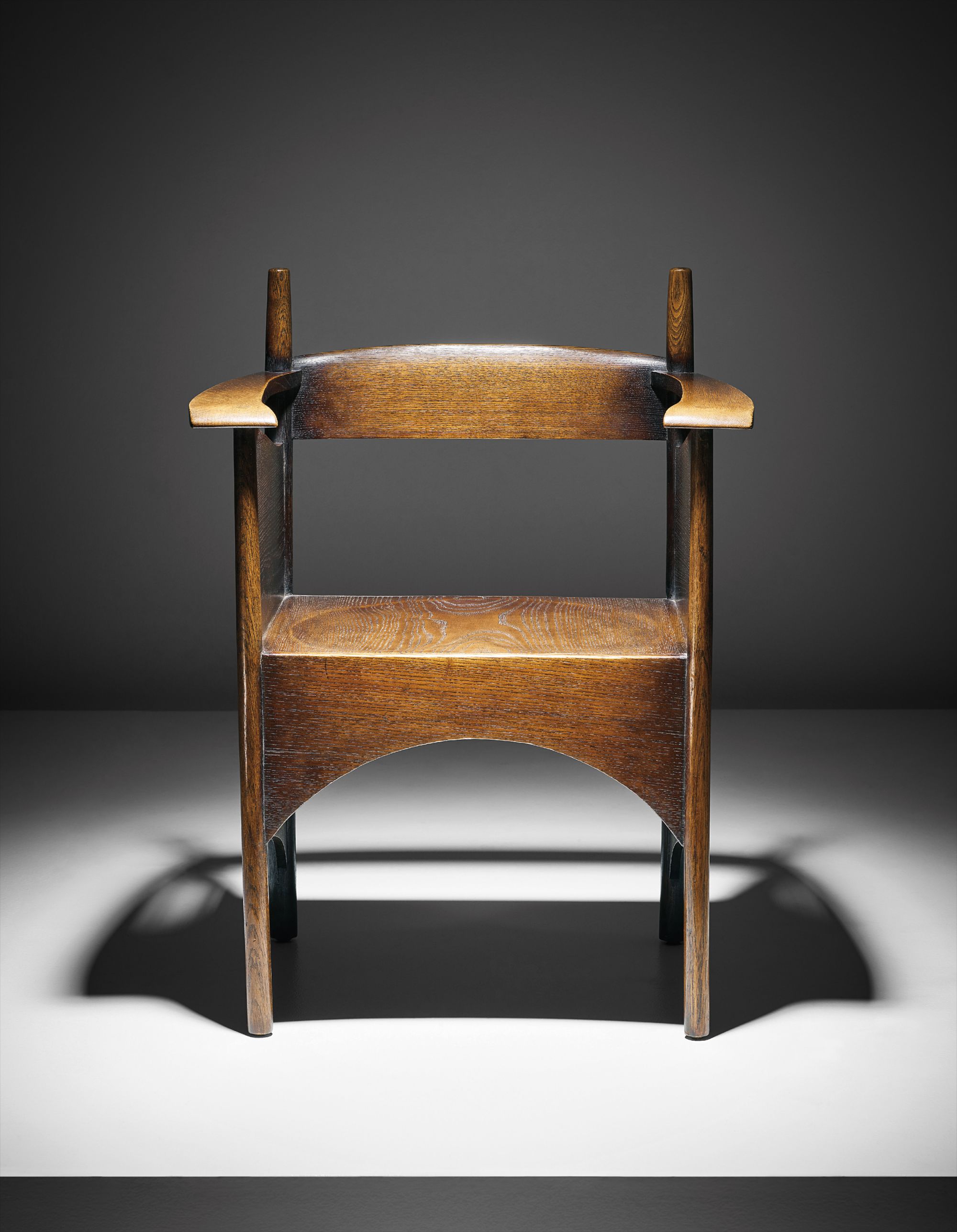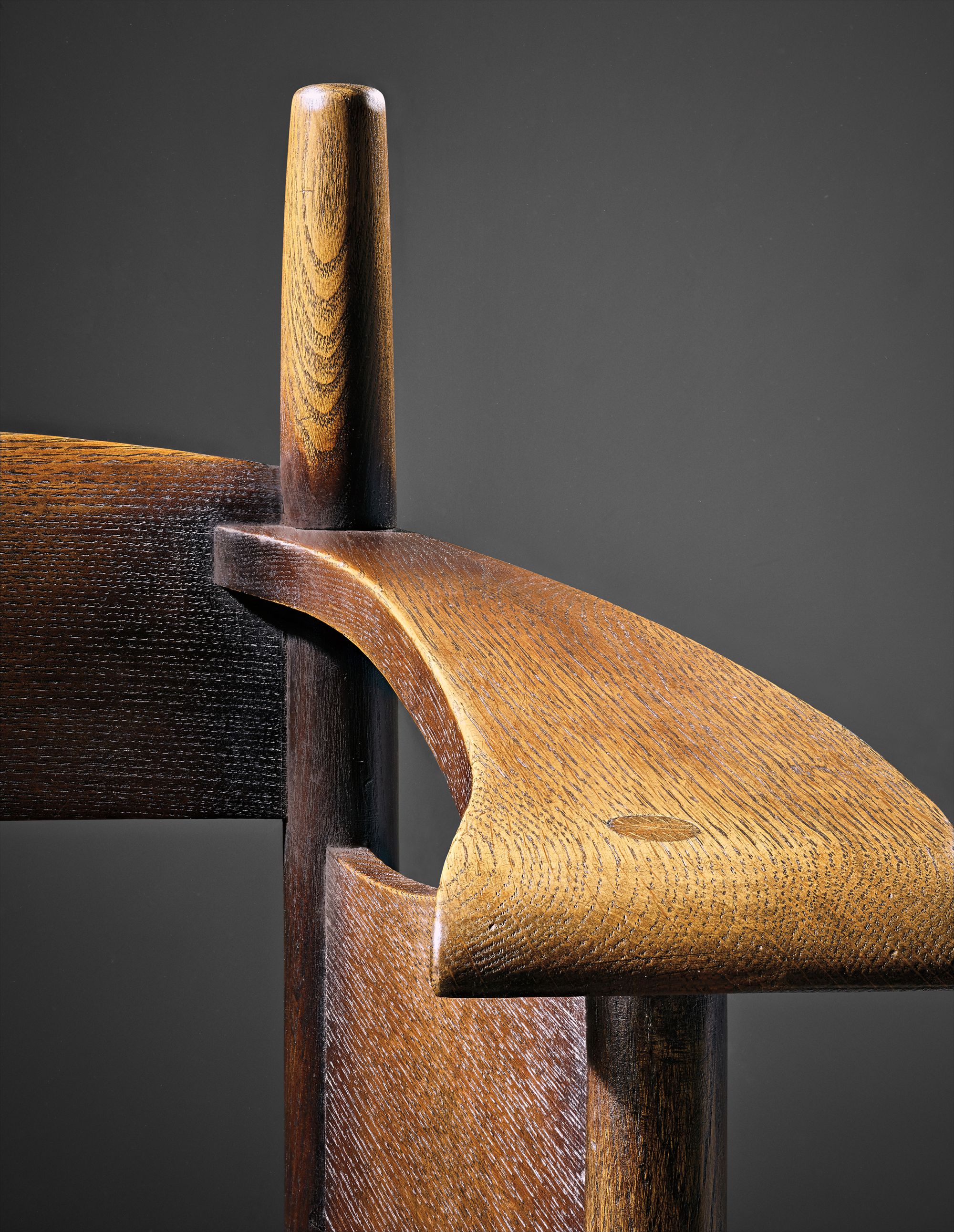





78
Charles Rennie Mackintosh
Armchair with low back, designed for the Billiards and Smoking Rooms, Argyle Street Tea Rooms
1898-1899
Stained chestnut, stained oak.
84 x 62.3 x 47.5 cm (33 1/8 x 24 1/2 x 18 3/4 in.)
Full-Cataloguing
The Scottish architect Charles Rennie Mackintosh designed the present lot for his first major independent commission, the Argyle Street Tea Rooms. Mackintosh relied on a relatively small number of patrons throughout his career. Among these patrons the Scottish proprietor Catherine (Kate) Cranston became an important and constant supporter of the architect’s work. Between 1896 and 1917 Cranston commissioned Mackintosh to design a series of tea rooms in Glasgow, which offered the city’s residents refuge from their urban surroundings. After commissioning Mackintosh to design stencilled wall decoration and light fittings for her first tea rooms at Buchanan Street (1896), Cranston then asked Mackintosh to design the furnishings for the Argyle Street Tea Rooms (1898-1899). The commission afforded Mackintosh a new freedom to experiment, whilst leading to further projects, including the Ingram Street Tea Rooms (1900) and the Willow Tea Rooms (1903), each of which granted the architect greater creativity and autonomy. Creating distinctive furniture designs featuring organic shapes and accentuated lines, Mackintosh fully integrated his furniture within its setting, using form to manipulate space to both aesthetic and functional ends.
Mackintosh’s armchair for the Argyle Street Tea Rooms was designed for the men’s Billiards and Smoking Rooms, which occupied the building’s top two floors above the tea and luncheon rooms. At the turn of the century, tea rooms were comprised of distinct spaces where men and women socialised together and separately. Accordingly, the furniture Mackintosh designed for the Argyle Street Tea Rooms functioned to define both social and physical space. Intended for male patronage, the furniture in the Billiards and Smoking Rooms featured strong and rectangular forms with bold outlines that carefully divided the pre-existing long, narrow rooms. The broad, curved arms and solid side panels comprising the form of the armchair were repeated throughout the rooms, creating a balanced composition of expressive lines and simple, organic shapes. Period photographs depict several of the armchairs set against and visually reinforcing the partitions that separated the Billiards Room from the adjoining Smoking Room. In contrast, within the Smoking Room Mackintosh sparingly positioned the armchairs with stools around different tables allowing for varied conversation among patrons.
Executed in dark-stained wood using traditional construction, Mackintosh’s furniture for the Argyle Street Tea Rooms combines elements of English Arts & Crafts and Scottish vernacular design. Further to imposing spatial structure within the larger interiors, the relationship between mass and space is also evident in Mackintosh’s individual furniture designs. The resulting furniture, as illustrated in the present lot, is often sculptural in effect. Anticipating the twentieth-century Modernist spirit of functionality, Mackintosh’s furniture for the Argyle Street Tea Rooms was intended for part of a complete interior to express the function of the room. However, as reflected in the subtle detailing of each piece, the resulting furniture stands both individually and harmoniously together.
Mackintosh’s armchair for the Argyle Street Tea Rooms was designed for the men’s Billiards and Smoking Rooms, which occupied the building’s top two floors above the tea and luncheon rooms. At the turn of the century, tea rooms were comprised of distinct spaces where men and women socialised together and separately. Accordingly, the furniture Mackintosh designed for the Argyle Street Tea Rooms functioned to define both social and physical space. Intended for male patronage, the furniture in the Billiards and Smoking Rooms featured strong and rectangular forms with bold outlines that carefully divided the pre-existing long, narrow rooms. The broad, curved arms and solid side panels comprising the form of the armchair were repeated throughout the rooms, creating a balanced composition of expressive lines and simple, organic shapes. Period photographs depict several of the armchairs set against and visually reinforcing the partitions that separated the Billiards Room from the adjoining Smoking Room. In contrast, within the Smoking Room Mackintosh sparingly positioned the armchairs with stools around different tables allowing for varied conversation among patrons.
Executed in dark-stained wood using traditional construction, Mackintosh’s furniture for the Argyle Street Tea Rooms combines elements of English Arts & Crafts and Scottish vernacular design. Further to imposing spatial structure within the larger interiors, the relationship between mass and space is also evident in Mackintosh’s individual furniture designs. The resulting furniture, as illustrated in the present lot, is often sculptural in effect. Anticipating the twentieth-century Modernist spirit of functionality, Mackintosh’s furniture for the Argyle Street Tea Rooms was intended for part of a complete interior to express the function of the room. However, as reflected in the subtle detailing of each piece, the resulting furniture stands both individually and harmoniously together.